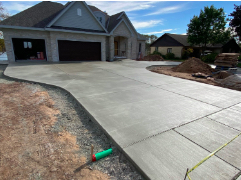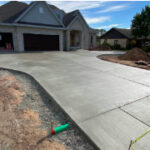 Concrete driveways are long-lasting, requiring minimal maintenance. They are also eco-friendly, as they do not rely on petroleum, a limited natural resource, for their production.
Concrete driveways are long-lasting, requiring minimal maintenance. They are also eco-friendly, as they do not rely on petroleum, a limited natural resource, for their production.
A reputable concrete contractor can help you choose the right materials and install your new driveway correctly. They can also answer any questions you may have about the process. Visit https://concretecontractorcoloradosprings.com/ for more details.
The thickness of a concrete driveway determines its ability to support the weight of vehicles and resist damage. The type and number of vehicles that will use the driveway, soil conditions, and climate will influence how thick a concrete slab needs to be. Concrete driveways can be poured as thin as four inches, but a slab that is six inches or more thick provides added strength and durability.
Non-reinforced concrete driveways four inches thick are adequate for most passenger vehicles. If you have a heavy vehicle like a truck or an RV, a six-inch slab is recommended. A thicker concrete driveway also has greater tensile and flexural strength, which will help it resist cracking.
Concrete is a dense material, but the size of the aggregates and the method of mixing impact its compressive strength. The best mix for a residential concrete driveway is one that has a compressive strength of 4,500 psi and contains 5% air, which improves workability and durability. The type of aggregate used is also a factor, since larger pieces tend to have better wear resistance.
In addition to the concrete mix, the thickness of the concrete and whether rebar is included all influence how much a slab can withstand. Rebar increases the tensile and flexural strength of concrete, which helps it resist cracking and damage from extreme weather conditions like freeze-thaw cycles, soil movement, or heavy loads. Concrete slabs that are less than 5″ thick don’t require rebar, but most reputable contractors will include it if the driveway is over 6″ thick.
The soil conditions that surround a concrete driveway are another major influencing factor. While concrete can be poured directly on undisturbed, solid soil, it’s a good idea to have the area evaluated by a professional to ensure the soil is suitable for a driveway and that it will remain stable over time.
If the soil is not able to bear the weight of a concrete driveway, it will need to be reinforced with a base and subbase before pouring the concrete. These layers will elevate the driveway and improve drainage. A geotechnical engineer can assess the soil and recommend the correct base and subbase for a specific site.
Durability
Concrete is one of the most durable paving materials available, making it a great choice for a driveway. It can hold up to heavy vehicles and resist cracking and settling better than asphalt. However, like any paved surface, it can be damaged by frost action or excessive rain. Regular resealing can prevent damage and extend the life of your concrete driveway.
The thickness of a concrete driveway will also affect its durability. Non-reinforced concrete four inches thick is standard, but areas that experience freezing winters or frequent rainfall require at least eight inches. Reinforcement can help increase the strength of your concrete, but it adds to the cost. A concrete contractor can advise you on the best thickness for your specific situation.
It is important to consider the drainage of your driveway before installing it. If you live in an area that experiences heavy rains, your concrete driveway may need to be sloped to drain water. This will prevent standing water from pooling and damaging the concrete.
A concrete driveway can be made more attractive and durable with the use of color, texture, or pattern. It can even be stained to mimic the appearance of pavers, stone tiles, or slate. It is also possible to incorporate designs and artwork into your concrete driveway. However, these additions can fade over time.
Concrete needs to cure properly in order to reach its full strength and durability. During this process, the concrete undergoes a chemical transformation that hardens and strengthens it. This is a slow process that requires the right conditions to occur. The temperature, humidity, and air pressure all play a role in curing concrete.
It is important to protect your new concrete driveway from the elements for at least seven days until it is fully cured. During this time, you should not park any vehicles on it. It is also a good idea to keep the driveway clear of debris such as rocks and sticks to prevent them from getting stuck in the concrete. If your driveway has small cracks or other damage, you can repair them with a concrete patching compound. This compound is available at most hardware stores and comes with all the tools you need to apply it.
Aesthetics
A driveway isn’t just a practical feature that allows vehicles to access a home; it can also be a beautiful accent piece that adds to the overall aesthetic of the home. If you are looking to create a concrete driveway that is both durable and attractive, there are many options to choose from.
One way to add visual interest to a concrete driveway is by using pavers to separate the slabs of concrete. This can create a more traditional look that is appealing to those who like a mix of textures and colors. The pavers can be made of different materials, such as stone or wood, to create a unique look that complements the home’s exterior.
Another option to consider for a concrete driveway is one that is paved with stone tiles. These can be more modern-looking than a slab of concrete, and they offer the added benefit of being able to be easily moved in the event of an emergency. They can be installed in a grid pattern to make the driveway more visually appealing, or they can be placed randomly for a more natural look.
You can also enhance the look of a concrete driveway by using a broom finish. This is a technique that involves brushing the surface of the concrete before it is dry, which makes it slightly rougher but still smooth enough to drive on. This is a great choice for those who want to keep the look of their concrete driveway simple but elegant.
Concrete can also be stained to give it a more colorful appearance. This is a good option for those who want their concrete to match the color of their home or to create a bold statement that contrasts with the rest of the house.
You can even choose to stencil your concrete, which is a great idea for those who are not in the mood to do a full remodel of their driveway. Stencils can be used to create the look of brick, slate tiles, cobblestones, and more. They can be applied to new concrete or existing ones, and they can also be used to resurface older concrete driveways.
Maintenance
Concrete is tough and durable, but it can be damaged if not cared for properly. Damage can be caused by a number of factors, including age, weather, and traffic. It is essential to repair any cracks and fissures as soon as they appear to prevent them from worsening. This helps to extend the life of the driveway and reduce the risk of costly repairs in the future.
It is also important to be mindful of where you park your vehicle to avoid putting unnecessary stress on the concrete. This can cause it to crack, and it is especially important to keep vehicles away from the edges of the driveway, which are the most vulnerable points.
In addition, it is a good idea to clear a two- to three-inch strip around the edges of the driveway to provide a runoff area for snow and rain. This can help prevent water and chemicals from seeping into the concrete. It is also helpful to redirect downspouts so that they don’t empty directly onto the concrete, which can lead to surface damage.
Chemicals like de-icers can be particularly harmful to concrete as they penetrate surfaces and break down the structures underneath. It is best to use alternatives, such as sand, coffee grounds, alfalfa meal, or kitty litter, to melt ice and make surfaces less slippery.
It is a good idea to apply a sealant to the concrete surface every few years to protect it from dirt and grime. It is important to clean the concrete before applying the sealant, and it should be allowed to dry according to the product instructions.
Another important maintenance tip is to take care of any rodent problems as soon as they arise. Mice and chipmunks can cause serious damage to concrete driveways by burrowing under the slabs and creating tunnel networks. This can weaken the foundation that the concrete is sitting on and eventually lead to sinking and severe slab damage. This is a problem that can be difficult to repair, so it’s a good idea to keep an eye out for signs of rodent activity and take precautions accordingly.




